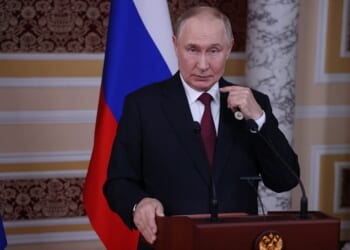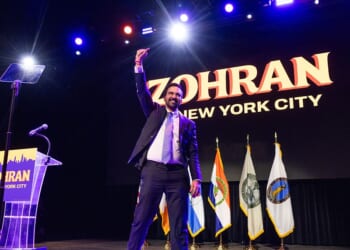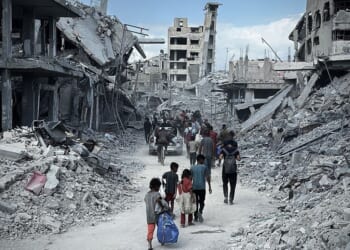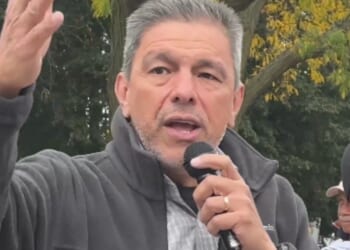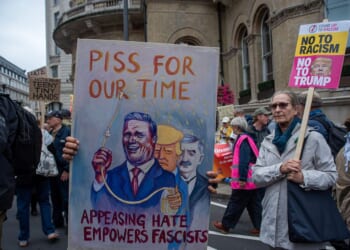Today, as European nations find themselves engaged in an escalating cold war with Russia, it is difficult not to look back on the actual Cold War with something approaching nostalgia. Then, for the most part, the rules of confrontation were clear; the frontiers were clearly drawn and zealously guarded, and the two opposing ideologies which had carved up a continent between them managed, for the most part, to sublimate their rivalries into a contest of prestige over technology, sport and culture. Even the rare moments of cultural diplomacy between East and West were shot through with competition, as art became a battleground for ideological supremacy. And in this ambiguous story of rivalry through cooperation, there is surely no more expressive testament than the Soviet-Ukrainian director Sergei Bondarchuk’s great film epic Waterloo, released 55 years ago this month.
A lavish Soviet-Italian co-production featuring a mostly British and American cast, Waterloo was a pronounced flop at the time, its box office failure putting paid to Kubrick’s chances of making his own Napoleon film. Yet Waterloo has since won a devoted audience for its unreplicable scope, unlike anything else in English-language cinema. “You just couldn’t afford to get that many people together in Hollywood or anywhere else,” Bondarchuk boasted at the time. He was right: 15,000 Soviet infantry conscripts march across the screen and then die — the film ends with the entire cast of extras sprawled dead across the battlefield — in what is surely the only English-language work of socialist realism. Any small boy fighting battles on the living-room floor — or any adult wargamer — will recognise the joy and loving attention to detail with which Bondarchuk assembles and then destroys his vast armies.
The peacock brilliance of the era’s uniforms lend themselves to such reveries, yet the bloody business of war is not evaded. Ranks of cannon belch smoke and flame; sabres glitter in five separate, lovingly-filmed cavalry charges; entire hillsides flicker with campfire light on the eve of battle; and thousands of troops ford rivers and trudge through the mud: the dazzling scale is the film’s entire point. Ostensibly an anti-war movie, the effect is instead of a kind of boyish war pornography: for all the pointless deaths, in a film in which all deaths are inglorious, the film’s message is subverted by the sheer spectacle of it all.
Flitting between the perspectives of the great generals, whose unruffled exteriors mask inner doubt, voiced by interior monologues, and the sheer terror of the ordinary soldiers, the film has a marked Tolstoyan quality. The effect is entirely intentional: its genesis was in Bondarchuk’s earlier adaptation of War and Peace, a state-mandated prestige project explicitly calculated to cow the decadent West with its sheer scale and grandeur, the filmic equivalent of the contemporary space race.
Born in the southern Ukrainian village of Bilozerka, Bondarchuk was conscripted into the Soviet Army in 1942, serving in the Caucasus front south of Stalingrad. At one point in Grozny, according to the Mosfilm studio, Bondarchuk sheltered from an artillery barrage “in a trench that could become his grave at any moment… It seemed as if the earth was burning and iron was melting. The eerie smell of charred human flesh permeated the air.” Pressing himself into the dirt, he locked eyes with a stray dog, its fur scorched by flame, which had approached his foxhole: “Sergei Fyodorovich remembered the dog’s gaze, filled with terror, for the rest of his life. Later, in a scene from War and Peace, he filmed the eyes of a wolf who also looked at people as monsters.” As Bondarchuk later remarked in his treatise on acting, “I belong to the generation that the war found in the prime of life, which took part in it and repaid with their lives for the joy of a peaceful life. The war still leaves a wound in the soul.”
Yet the war’s horror and suffering was also for the Soviet Union a kind of apotheosis: victory over the Nazi invader elevated the USSR into a great imperial state, the master of half of Europe and a great power as never before or since in Russia’s history. Having won the war, the Soviet Union now contested the contours of an uneasy peace in which open conflict was, for the most part, too terrible to contemplate. And so, just as the Cuban Missile Crisis broke, Bondarchuk was for the second time in his life conscripted for a great state-directed battle of prestige: for only his second directorial feature, he was chosen by the Soviet Ministry of Culture to direct War and Peace, a riposte to Hollywood’s recent adaptation of Tolstoy’s epic. As the historian Denise Youngblood observes, Bondarchuk’s War and Peace “was a tribute to the might and righteousness of the Russian people, which fit well with the Russocentrism of the USSR in the late Sixties under Brezhnev. A Russian victory was a Soviet victory.” Still the most expensive film ever made — around $700 million in today’s money — Bondarchuk’s seven-hour epic (watchable for free on Mosfilm’s YouTube account) succeeds more than anything through sheer scale.
War and Peace was planned like a military campaign, deploying thousands of Red Army troops to recreate the great battles of Austerlitz and Borodino. And like Russian military campaigns before and since, the production typified not only the wasteful planning failures but also the vast resources, as well as the sheer dogged determination, which only Mother Russia could bring to bear in executing the will of its leaders. A scale replica of Moscow was built and burned to the ground as a backdrop, against which his actors had only one chance to deliver their lines perfectly or wreck the entire production. Banned from using Western film stock, Bondarchuk struggled with the poor quality reels available to him, with mosquitoes embedded in the emulsion, often having to reshoot entire scenes with his cast of thousands when the film failed. His staff cowered before him, as he became an increasingly dictatorial presence on set. “The director has studied all the material for the film; he alone knows everything,” Bondarchuk wrote at the time. “He is tsar and god.”
Such was the stress of the film’s production, and the unreasonable schedule forced on him by the Kremlin, that Bondarchuk died twice making it. Resuscitated from both heart attacks, the second time after four minutes of clinical death in which his experience of blinding white light later inspired Prince Bolkonsky’s death scene, a near-broken Bondarchuk still delivered his epic on time. The effect was as dazzling as intended. Bondarchuk’s innovation of the “cannonball-eye view”, where the camera hurtles towards the ground and its doomed human targets, achieved everything the Kremlin had desired of him. “English filmmakers, seeing the footage shot with a “flying camera,” asked… in amazement: “How was this filmed?!”, Mosfilm’s website still boasts: “That’s how it was filmed — Russian ingenuity and military technology.” In 1969, the same year War and Peace won the first ever Soviet Oscar for best foreign-language film, Bondarchuk began filming Waterloo.
For its own obscure reasons, the Soviet state had decreed that filming should take place in Uzhgorod, then on the Soviet Union’s far-western border, and today that of Ukraine. The region was a closed military zone, to the frustration of the Western publicity department struggling to bring journalists to the set. Only the year before, soldiers from the Transcarpathian Military District had crossed the border to crush the Prague Spring. The grizzled extras portraying Napoleon’s Old Guard had taken part in the campaign, a swift and forceful decapitation of a wavering client state Putin would later try, and fail, to replicate in Ukraine. Eleven of the 128th Guards Motor Rifle Division, one of the units drafted to make the film, had been killed in Czechoslovakia: today a Mountain Assault Division fighting for independent Ukraine against Russia, its modern successors suffer far higher casualties grappling with the Kremlin’s current wasteful prestige project.
The region’s sloping vineyards, in the foothills of the Carpathians, make a poor visual match for Belgium: instead of filming somewhere flatter, the Soviet Army Corps of Engineers levelled two hillsides in a vast geoengineering project simply, one assumes, because they could. Five thousand trees were planted to create a forest for Napoleon’s infantry to fight through, and six miles of irrigation pipes laid to recreate the muddy conditions of the battlefield. Amputee veterans of the Great Patriotic War were rounded up from surrounding villages to add a touch of body horror (later excised by the film’s Western editors). Horses requisitioned from nearby collective farms were injected with vodka to play dead: most then died as a result. An unknown number of horses were also killed in stunt scenes only filmed when the “sentimental English” cast were away from set, and since excised from broadcast. One trooper was trampled to death in the film’s great cavalry charge sequence, the Italian cameraman Daniele Nannuzzi would later reveal: “He goes down and the horses all ran over on his body. One Russian soldier in Russia — the life of one man was not so important at this time.”
Many of the film’s most distinctive sequences — the general soberly riding off a battlefield littered with corpses at the end, the aerial shots of Ney’s doomed cavalry sweeping and breaking against infantry squares — were directly lifted from Bondarchuk’s 35-minute long depiction of the Battle of Borodino in War and Peace. Yet the effect is even more dazzling. With Waterloo, Bondarchuk was granted the opportunity to reduce War and Peace to its most spectacular essence: stripping away the tortured love affairs, high-society gossip and philosophical discursions to present two hours of pure, lovingly filmed combat. Few films can ever have blurred the line more effectively between entertainment and generalship: the film’s senior military consultant, the Hero of the Soviet Union Lt Gen Alexander Luchinsky, had commanded the 28th Army in Operation Bagration, the largest and most successful Allied action of the entire war.
The result is overpowering: war has simply never been filmed like this, before or since. And if there is one thing that Waterloo brings to the screen that is beyond all comparison, it is the film’s depiction of cavalry. The scene depicting the charge of the Scots Greys — filmed, in part, in dreamlike slow motion, channeling Lady Butler’s “Scotland Forever!” — and the counter-charge of Napoleon’s Polish Lancers is rightly celebrated as one of the great spectacles of cinema. So expressive is the scene of the vanished chivalry of war, so alien to the grim, drone-haunted battlefields of today’s Ukraine, that it comes as a shock to realise that the Soviet Union had only stood down its last cavalry division 14 years before filming began. Indeed, contrary to popular modern narratives, the Soviet Army had massively expanded its cavalry forces during the Second World War, and utilised them profitably across a landscape which, today as then, horses can negotiate more easily than armoured vehicles. In making War and Peace, Bondarchuk and his cavalry consultant, Lt Gen Nikolai Oslikovsky, who had successfully commanded the 3rd Guard Cavalry Corps across the Eastern Front all the way to the Elbe — it was Oslikovsky’s cavalry scouts who famously linked up with advancing American troops — proposed that the Red Army form a cavalry unit purely for film purposes. The proposal was accepted by the Kremlin: Oslikovsky, who had finished his soldiering career as the commandant of the Higher Red Banner Cavalry Officer School, requisitioned mounts and riders from the Transcaucasian and Turkestan Military Districts, where horse-drawn mountain artillery was still in use, and re-activated recently retired cavalry officers and NCOs to train a new generation of horsemen.
“The result is overpowering: war has simply never been filmed like this, before or since.”
Just as did War and Peace, Waterloo spectacularly employed the 1,500 troopers of Bondarchuk’s new creation, the 11th Separate Cavalry Regiment now attached to Mosfilm Studios, supplemented by the Arabian horses and riders of the Moscow Militia. When we watch the cavalry charges in Waterloo, what we are witnessing is not merely thrilling filmmaking but an unbroken link in Russia’s cavalry history, stretching back long beyond the Soviet Union to the cossack units of Tsarist Russia, and beyond them to the furthest historical horizon of the Eurasian Steppe: these few glorious minutes are built on thousands of years of tradition. In making War and Peace, and then Waterloo, Bondarchuk saved this historical link to Russia’s military past: it is no accident, perhaps, that the 11th Separate Cavalry Regiment has since been repurposed as a prominent component of Putin’s Presidential Guard, responsible for the Kremlin’s defence as well as glittering ceremony.
After all this effort and expense, Waterloo’s box office failure came as a heavy blow to Bondarchuk, bitterly echoing Napoleon’s line in the film that “They will chain you like Prometheus to a rock where the memory of your own greatness will gnaw you.” The Soviet film journals long refused to review it. While War and Peace is now rapturously received among Western film enthusiasts, Waterloo’s reassessment as a masterpiece has been slower in coming: its reputation is greater amongst military history enthusiasts than cinephiles, yet it is, perhaps, the better film.
Freed from the constrictions of fidelity to a beloved classic, its pacing is tighter and its character portraits more expressionistic. Flitting between the interiority of self-doubt and the compulsion to impose a mark on the world, worn down by the tyranny of schedules and constraints of logistics, the line between great general and director is hard to parse. The Napoleon of Waterloo, physically broken but still imbued with greatness, is a more sympathetic one than of War and Peace, or indeed that of Christopher Plummer’s Wellington, who Le Monde’s critic remarked had been unfairly traduced by presenting him “in his most British aspect.” As Bondarchuk declared, “From the Russian point of view, even though Napoleon was our enemy at one point, he was also the representative of revolutionary principles. Wellington was the representative of reactionary principles.” So too, in time, was Bondarchuk, marginalised during Glasnost as a “Right-wing” figure.
Yet if Bondarchuk’s career provides an ambiguous portrait of a Soviet life, it is the great and terrible potential of Russia, so coldly wasteful and crushingly impressive, that shines through his work. As the film historian David Gillespie remarks, “Bondarchuk’s War and Peace contains some of the most thrilling and large scale battle scenes ever filmed, but it remains a paean to Russian military might and the strength of the Russian soul.” Much the same can be said of Waterloo, a film which contains not a single Russian character: the effect is, at times, disquieting. Only Russia could bring to bear such a dizzying quantity of resources and sheer willpower to a prestige project that makes no rational sense to Western eyes: contemporary parallels are not hard to reach for.
Bondarchuk’s birthplace of Bilozerka is today a frontline position ravaged by Russian artillery and FPV drones, an innovation of the Ukraine war whose terrifying, hawk-like perspective was uncannily prefigured by the director’s invention of the “cannon-ball eye” view; his son Fyodor, a Putin loyalist, is best known for his modern war epic 9th Company, and for his public advocacy of conquest against Ukraine. “Next to a battle lost, the saddest thing is a battle won,” remarks Wellington at the film’s conclusion: yet the film’s scale and grandeur subverts its own anti-war message, just as the human cost fails to dent Napoleon’s inhumane glory. As Ukraine’s countryside once again provides a stage for the Kremlin to overawe the West, and as the Russian army fighting there once again stands up cavalry forces, returning to the timeless tradition of the Steppe to counteract technology, Bondarchuk’s masterpiece has acquired a discomfiting new resonance.











